-
 Bitcoin
Bitcoin $107,341.7259
0.15% -
 Ethereum
Ethereum $2,438.6204
0.70% -
 Tether USDt
Tether USDt $1.0003
-0.02% -
 XRP
XRP $2.1866
1.94% -
 BNB
BNB $649.0952
0.36% -
 Solana
Solana $150.9602
5.63% -
 USDC
USDC $0.9999
0.00% -
 TRON
TRON $0.2742
0.40% -
 Dogecoin
Dogecoin $0.1645
1.93% -
 Cardano
Cardano $0.5669
1.18% -
 Hyperliquid
Hyperliquid $37.8286
4.19% -
 Bitcoin Cash
Bitcoin Cash $491.4669
-2.74% -
 Sui
Sui $2.8150
3.06% -
 Chainlink
Chainlink $13.4184
2.91% -
 UNUS SED LEO
UNUS SED LEO $9.0809
0.27% -
 Avalanche
Avalanche $18.0295
2.60% -
 Stellar
Stellar $0.2396
1.19% -
 Toncoin
Toncoin $2.8587
0.13% -
 Shiba Inu
Shiba Inu $0.0...01160
2.59% -
 Litecoin
Litecoin $86.4192
1.45% -
 Hedera
Hedera $0.1486
1.19% -
 Monero
Monero $308.4324
0.87% -
 Polkadot
Polkadot $3.4202
1.43% -
 Bitget Token
Bitget Token $4.6436
-0.34% -
 Dai
Dai $0.9998
-0.02% -
 Ethena USDe
Ethena USDe $1.0002
0.00% -
 Uniswap
Uniswap $7.1527
3.29% -
 Pi
Pi $0.5357
-8.45% -
 Pepe
Pepe $0.0...09588
4.61% -
 Aave
Aave $259.9759
0.81%
Can I buy the bottom after three consecutive negative shrinkages reach the support level?
Three consecutive negative shrinkage candles at a key support level may signal a potential bullish reversal in crypto, but confirmation and risk management are crucial.
Jun 29, 2025 at 03:43 am
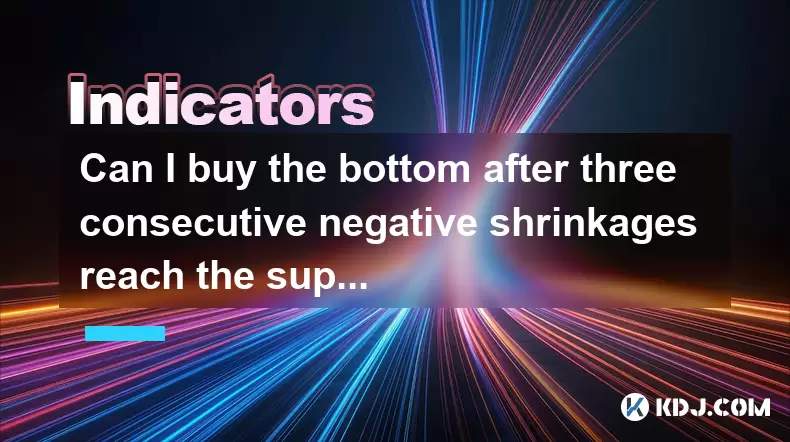
Understanding the Context of Three Consecutive Negative Shrinkages
In the cryptocurrency market, price patterns are often analyzed to predict potential reversals or continuations. A negative shrinkage refers to a situation where the candlestick body becomes smaller in a downtrend, indicating weakening selling pressure. When this happens three times consecutively, it may signal that bears are losing control and bulls might be preparing for a comeback.
Traders often wonder whether such a pattern, especially when it coincides with a known support level, presents a valid opportunity to buy the bottom. It's important to understand that while technical indicators can provide insights, they do not guarantee outcomes. The presence of multiple negative shrinking candles at a key support zone increases the probability of a reversal, but confirmation is still required before making any trade decision.
A key takeaway here is that three consecutive negative shrinkages may indicate exhaustion in the downtrend.
Identifying Reliable Support Levels
Before considering a buy setup after three shrinking red candles, it's essential to confirm that the price has reached a reliable support level. Support levels can be identified through various methods:
- Historical price zones where previous bounces occurred
- Fibonacci retracement levels, particularly the 0.618 or 0.786 levels
- Trendline breaks that have been retested
- Moving averages, especially the 200-day SMA or 50-day EMA
It’s crucial that these supports are not arbitrary. They must have been tested multiple times in the past to validate their strength. If the three negative shrinkages occur precisely at one of these well-established support areas, the likelihood of a bounce increases significantly.
Support levels should be clearly defined and previously respected by the market to be considered reliable.
Analyzing Candlestick Patterns and Volume Behavior
After identifying the support level and observing three shrinking bearish candles, the next step involves analyzing the candlestick behavior and volume dynamics. Shrinking candles typically reflect indecision or reduced momentum among sellers. If each subsequent candle has a smaller body than the one before, it suggests that the downtrend is losing steam.
To further strengthen the case for buying, traders should look for:
- A bullish engulfing pattern following the shrinking candles
- An inside bar or pin bar forming at the support area
- Increasing volume on the fourth candle, signaling renewed buyer interest
Volume plays a critical role in confirming the validity of the reversal. If the volume starts to rise as the price reaches the support, it indicates that buyers are stepping in. Conversely, if volume remains low, the bounce might lack strength.
Volume analysis is a powerful tool to confirm whether the reversal has real buying conviction behind it.
Entry Strategies and Risk Management
Once the conditions align — three negative shrinkages, support level touch, and bullish candlestick confirmation — traders may consider entering a long position. However, it's vital to structure the entry and manage risk effectively.
Here are steps to follow:
- Place a limit order slightly above the close of the bullish confirmation candle
- Set a stop-loss below the support level to protect against false breakouts
- Use a risk-reward ratio of at least 1:2 to ensure profitability over time
- Consider scaling into the position if the price continues to hold above support
Timing the exact bottom is risky, so partial entries or waiting for a confirmed close above the shrinking candles can improve accuracy. Traders who rush in without confirmation often face losses if the support breaks.
Proper risk management is non-negotiable when attempting to buy near the bottom of a downtrend.
Backtesting and Historical Validation
Before applying this strategy live, it's wise to backtest it across multiple crypto assets and timeframes. Look for historical instances where three negative shrinkages occurred at strong support levels and track how often a reversal followed.
When backtesting:
- Use clean chart data from exchanges like Binance or Bybit
- Test across major coins like BTC, ETH, and altcoins
- Evaluate both daily and 4-hour charts
- Record win rate, average gain/loss, and drawdowns
By doing this, you’ll get a clearer picture of whether the strategy has statistical merit or if it's just an appealing visual pattern.
Backtesting helps distinguish between emotional trading and a strategy with proven edge.
Frequently Asked Questions
Q: What is a negative shrinkage candle?
A negative shrinkage candle occurs during a downtrend when the bearish candle's body becomes progressively smaller, indicating diminishing selling pressure.
Q: Can I apply this strategy on all cryptocurrencies?
While the concept applies broadly, not all cryptocurrencies react the same way. Major coins like BTC and ETH tend to respect technical levels more than smaller altcoins due to higher liquidity and institutional influence.
Q: Is it safe to buy the bottom even if there are no fundamental reasons supporting a rebound?
Technically, yes, as price action can precede fundamentals. However, buying without context increases risk. Always consider broader market sentiment and macro factors.
Q: How many times should the support level have been tested to be considered strong?
Ideally, a support level should have been tested at least two or three times previously to be considered significant.
Disclaimer:info@kdj.com
The information provided is not trading advice. kdj.com does not assume any responsibility for any investments made based on the information provided in this article. Cryptocurrencies are highly volatile and it is highly recommended that you invest with caution after thorough research!
If you believe that the content used on this website infringes your copyright, please contact us immediately (info@kdj.com) and we will delete it promptly.
- Ruvi AI: The Audited Token Primed to Lead the Bull Run, Outshining Competitors
- 2025-06-29 06:30:13
- Ruvi AI: The Smart Shiba Inu? Token Rally Potential Examined
- 2025-06-29 06:30:13
- Bitcoin, AI Tokens, and Ruvi AI: What's the Deal?
- 2025-06-29 06:50:12
- Cryptos with Real-World Utility and Growth Potential: Qubetics and Beyond
- 2025-06-29 06:35:13
- Ruvi AI, Dogecoin, and ROI: Decoding the Crypto Hype
- 2025-06-29 07:12:05
- Unstaked vs. Dogecoin & Ethereum: The Next Big Crypto Opportunity?
- 2025-06-29 07:15:12
Related knowledge
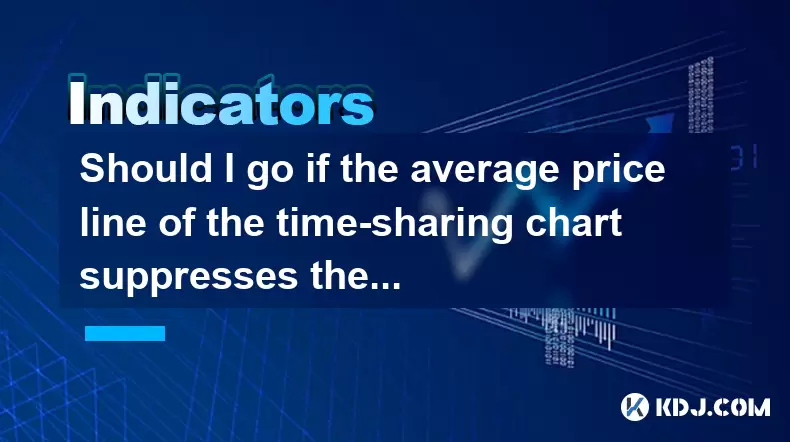
Should I go if the average price line of the time-sharing chart suppresses the rebound?
Jun 28,2025 at 05:14pm
Understanding the Time-Sharing Chart and Average Price LineThe time-sharing chart is a real-time chart used in cryptocurrency trading to visualize price movements over short intervals, typically within a single trading day. It provides traders with insights into intraday volatility and momentum. The average price line, often calculated as a moving avera...
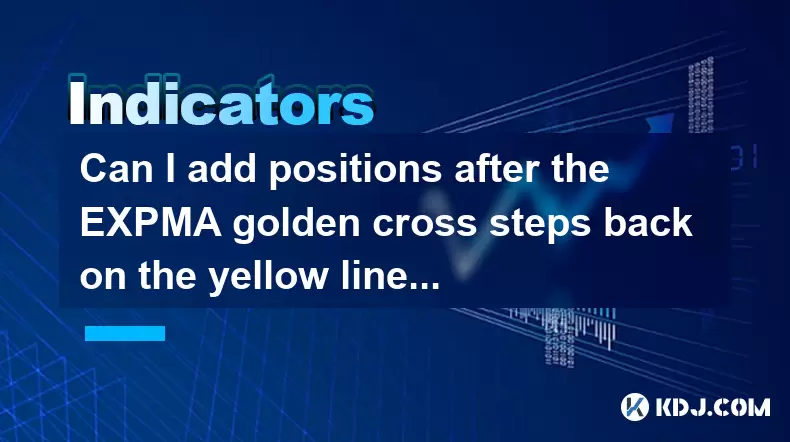
Can I add positions after the EXPMA golden cross steps back on the yellow line?
Jun 28,2025 at 11:57am
Understanding the EXPMA Indicator and Its RelevanceThe EXPMA (Exponential Moving Average) is a technical analysis tool used by traders to identify trends and potential entry or exit points in financial markets, including cryptocurrency trading. Unlike simple moving averages, EXPMA gives more weight to recent price data, making it more responsive to new ...

How to operate the next day after the daily limit is released with huge volume?
Jun 28,2025 at 12:35pm
Understanding the Daily Limit and Its ReleaseIn cryptocurrency trading, daily limits are often set by exchanges to manage volatility or during periods of high market activity. These limits can restrict how much an asset's price can fluctuate within a 24-hour period. When the daily limit is released, it typically means that the price cap has been lifted,...
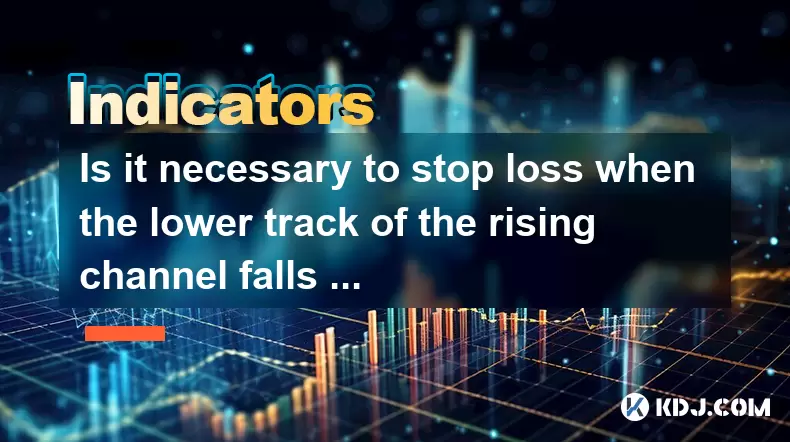
Is it necessary to stop loss when the lower track of the rising channel falls below?
Jun 28,2025 at 05:29pm
Understanding the Rising Channel PatternThe rising channel pattern is a popular technical analysis tool used by traders to identify potential upward trends in asset prices. It consists of two parallel lines: an upper resistance line and a lower support line, both sloping upwards. The price action typically oscillates between these boundaries, offering o...

Can I buy the bottom after three consecutive negative shrinkages reach the support level?
Jun 29,2025 at 03:43am
Understanding the Context of Three Consecutive Negative ShrinkagesIn the cryptocurrency market, price patterns are often analyzed to predict potential reversals or continuations. A negative shrinkage refers to a situation where the candlestick body becomes smaller in a downtrend, indicating weakening selling pressure. When this happens three times conse...
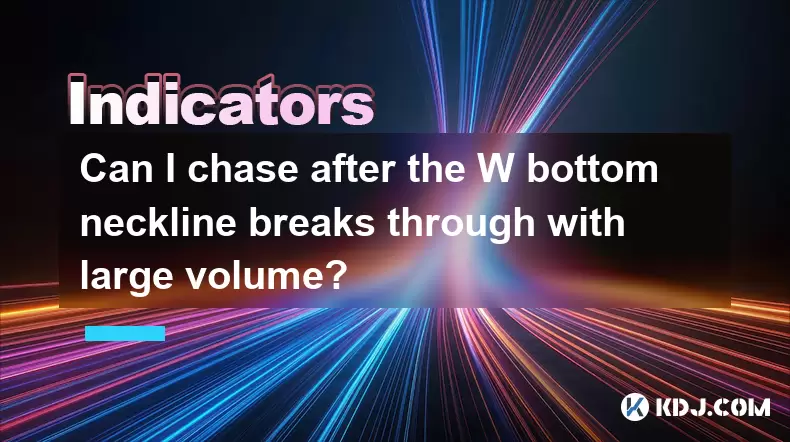
Can I chase after the W bottom neckline breaks through with large volume?
Jun 28,2025 at 07:28am
Understanding the W Bottom Pattern in Cryptocurrency TradingThe W bottom pattern is a common technical analysis formation used by traders to identify potential bullish reversals. In cryptocurrency markets, this pattern typically appears after a downtrend and signals that the selling pressure may be diminishing. The structure of the W bottom includes two...

Should I go if the average price line of the time-sharing chart suppresses the rebound?
Jun 28,2025 at 05:14pm
Understanding the Time-Sharing Chart and Average Price LineThe time-sharing chart is a real-time chart used in cryptocurrency trading to visualize price movements over short intervals, typically within a single trading day. It provides traders with insights into intraday volatility and momentum. The average price line, often calculated as a moving avera...

Can I add positions after the EXPMA golden cross steps back on the yellow line?
Jun 28,2025 at 11:57am
Understanding the EXPMA Indicator and Its RelevanceThe EXPMA (Exponential Moving Average) is a technical analysis tool used by traders to identify trends and potential entry or exit points in financial markets, including cryptocurrency trading. Unlike simple moving averages, EXPMA gives more weight to recent price data, making it more responsive to new ...

How to operate the next day after the daily limit is released with huge volume?
Jun 28,2025 at 12:35pm
Understanding the Daily Limit and Its ReleaseIn cryptocurrency trading, daily limits are often set by exchanges to manage volatility or during periods of high market activity. These limits can restrict how much an asset's price can fluctuate within a 24-hour period. When the daily limit is released, it typically means that the price cap has been lifted,...

Is it necessary to stop loss when the lower track of the rising channel falls below?
Jun 28,2025 at 05:29pm
Understanding the Rising Channel PatternThe rising channel pattern is a popular technical analysis tool used by traders to identify potential upward trends in asset prices. It consists of two parallel lines: an upper resistance line and a lower support line, both sloping upwards. The price action typically oscillates between these boundaries, offering o...

Can I buy the bottom after three consecutive negative shrinkages reach the support level?
Jun 29,2025 at 03:43am
Understanding the Context of Three Consecutive Negative ShrinkagesIn the cryptocurrency market, price patterns are often analyzed to predict potential reversals or continuations. A negative shrinkage refers to a situation where the candlestick body becomes smaller in a downtrend, indicating weakening selling pressure. When this happens three times conse...

Can I chase after the W bottom neckline breaks through with large volume?
Jun 28,2025 at 07:28am
Understanding the W Bottom Pattern in Cryptocurrency TradingThe W bottom pattern is a common technical analysis formation used by traders to identify potential bullish reversals. In cryptocurrency markets, this pattern typically appears after a downtrend and signals that the selling pressure may be diminishing. The structure of the W bottom includes two...
See all articles

























































































